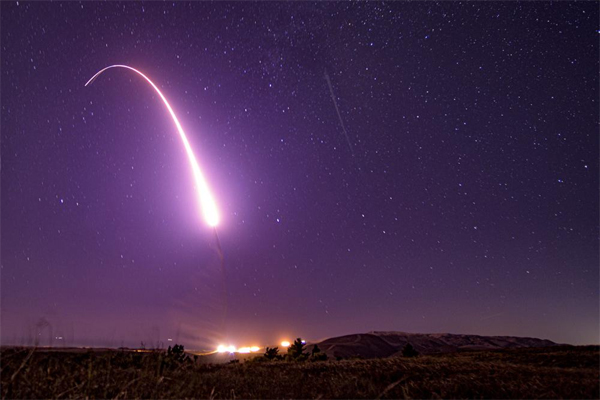
By Robert Burns/AP
WASHINGTON
EnergiesNet.com 02 03 2022
Joe Biden’s arrival in the White House nearly a year ago seemed to herald a historic shift toward less U.S. reliance on nuclear weapons and possibly a shrinking of their numbers. Even an American “no first use” pledge — a promise to never again be the first to use a nuclear weapon — seemed possible.
Then China happened — revelations about its expanding nuclear force and talk of potential war with Taiwan.
And then Russia happened — signs that it might be preparing to invade Ukraine.
Now, major shifts in U.S. nuclear weapons policy seem much less likely, and while Biden may insist on certain adjustments, momentum toward a historic departure from the Trump administration’s policy appears to have stalled.
The outlook will be clearer when the Biden administration completes its so-called nuclear posture review — an internal relook at the numbers, kinds and purposes of weapons in the nuclear arsenal, as well as the policies that govern their potential use. The results could be made public as early as January.
The biggest unknown is how forcefully Biden will weigh in on these questions, based on White House calculations of the political risk. During his years as vice president, Biden talked of new directions in nuclear policy. But heightened concerns about China and Russia would seem to improve the political leverage of Republicans seeking to portray such change as a gift to nuclear adversaries.
Russia became a more urgent focus of Biden’s attention after President Vladimir Putin in recent weeks sent an estimated 100,000 troops to positions near Ukraine’s border and demanded U.S. security guarantees. Biden and Putin discussed Ukraine by phone on Thursday, and senior American and Russian officials are scheduled to follow up with more detailed talks in Geneva on Jan. 9-10.
Tom Z. Collina, policy director at Ploughshares Fund, an advocate for nuclear disarmament, says the China and Russia problems complicate the politics of Biden’s nuclear review but should not stop him from acting to reduce nuclear dangers.
“We do not want a new nuclear arms race with either nation and the only way to prevent that is with diplomacy,” Collina said. “We must remember the main lesson we learned in the Cold War with Russia — the only way to win an arms race is not to run.”
In March, in what the White House called interim national security guidance, Biden said China and Russia had changed “the distribution of power across the world.”
“Both Beijing and Moscow have invested heavily in efforts meant to check U.S. strengths and prevent us from defending our interests and allies around the world,” the guidance said. Biden pledged to counter with actions to strength the United States at home, repair its alliances abroad and elevate the role of diplomacy. Nuclear weapons were mentioned only briefly.
“We will take steps to reduce the role of nuclear weapons in our national security strategy,” the guidance said without offering details, while also ensuring a safe and reliable U.S. nuclear force and seeking arms control opportunities.
Since then, worries about China and Russia have only increased. Private satellite imagery revealed last summer that China was building large numbers of new underground silos for nuclear missiles, and in November a Pentagon report said China may quadruple the size of its nuclear stockpile by 2030.
“Because of what China has done, it has really changed the complexion of this review,” says Robert Soofer, who was the Pentagon’s top nuclear policy official during the Trump administration and led a 2018 nuclear review.
“Rather than it being a review that examines reducing the role of nuclear weapons and even eliminating a leg of the triad, now they’ve been obliged to basically stay the course and determine how to tweak it at the margins.”
In June, even before the latest Russian troop buildup near Ukraine, the Pentagon’s policy chief, Colin Kahl, said the outlook for U.S. nuclear policy was colored not only by China’s nuclear ambitions but also by “real anxiety” among U.S. allies in Europe over Russian defense and nuclear policy.
“And so, obviously Russia is the wolf closest to the shed as it relates to the nuclear issue, but close behind is China’s desire to grow their nuclear arsenal, both quantitatively and qualitatively,” Kahl said June 23 at a nuclear policy conference sponsored by the Carnegie Endowment for International Peace.
Kahl did not preview the policy review outcome, but he said it is intended to fit inside a broader defense strategy, which also is to be published early in 2022.
The Pentagon has not publicly discussed details of the nuclear review, but the administration seems likely to keep the existing contours of the nuclear force — the traditional “triad” of sea-, air- and land-based weapons, which critics call overkill. It also may embrace a $1 trillion-plus modernization of that force, which was launched by the Obama administration and continued by Trump.
It’s unclear whether Biden will approve any significant change in what is called “declaratory policy,” which states the purpose of nuclear weapons and the circumstances under which they might be used.
The Obama administration, with Biden as vice president, stated in 2010 that it would “only consider the use of nuclear weapons in extreme circumstances to defend the vital interests of the United States or its allies and partners.” It did not define “extreme circumstances.”
Eight years later, the Trump administration restated the Obama policy but got more specific. “Extreme circumstances could include significant non-nuclear strategic attacks. Significant non-nuclear strategic attacks include, but are not limited to, attacks on the U.S., allied, or partner civilian population or infrastructure, and attacks on U.S. or allied nuclear forces, their command and control, or warning and attack assessment capabilities.”
Some believed that Biden as president would go a different direction, following his own advice on a “no first use” pledge. He said in a January 2017 speech: “Given our non-nuclear capabilities and the nature of today’s threats, it’s hard to envision a plausible scenario in which the first use of nuclear weapons by the United States would be necessary, or make sense.”
But some argue that China and Russia this year have changed “today’s threats,” perhaps keeping Biden on a cautious path.
By Robert Buyrns from AP
apnews.com 02 03 2022



